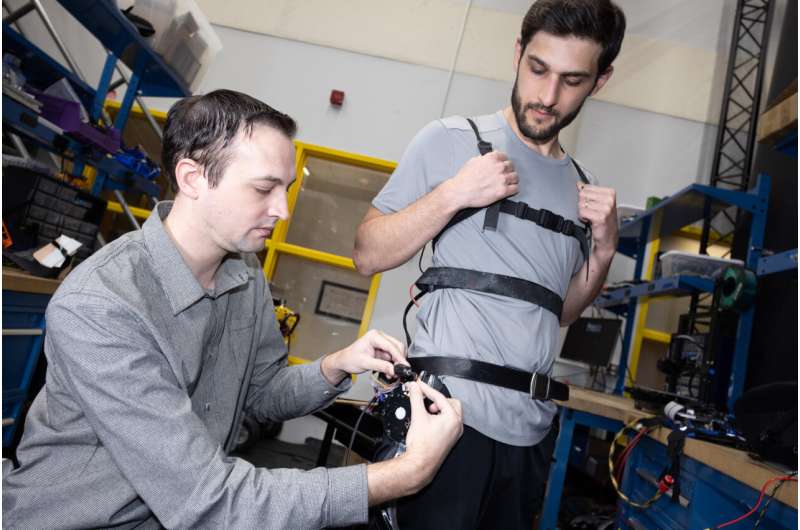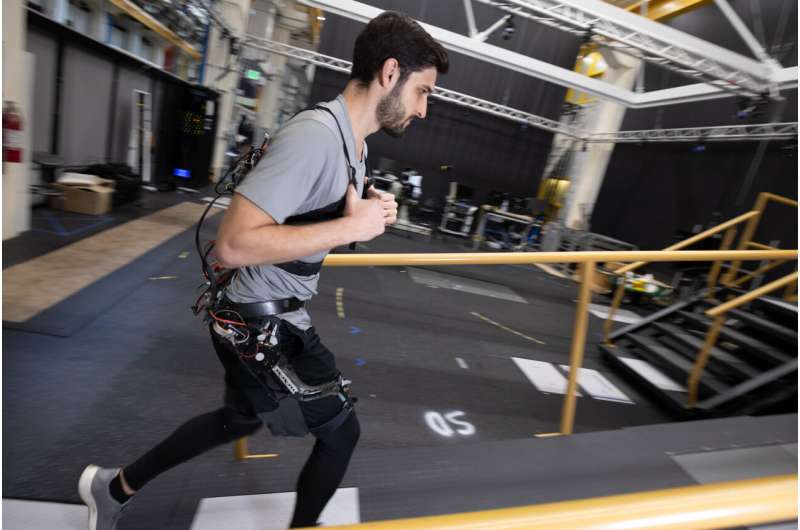
Robotic exoskeletons designed to help humans with walking or physically demanding work have been the stuff of sci-fi lore for decades. Remember Ellen Ripley in that Power Loader in “Alien”? Or the crazy mobile platform George McFly wore in 2015 in “Back to the Future, Part II” because he threw his back out?
Researchers are working on real-life robotic assistance that could protect workers from painful injuries and help stroke patients regain their mobility. So far, they have required extensive calibration and context-specific tuning, which keeps them largely limited to research labs.
Mechanical engineers at Georgia Tech may be on the verge of changing that, allowing exoskeleton technology to be deployed in homes, workplaces, and more.
A team of researchers in Aaron Young’s lab has developed a universal approach to controlling robotic exoskeletons that requires no training, no calibration, and no adjustments to complicated algorithms. Instead, users can don the “exo” and go.
Their system uses a kind of artificial intelligence called deep learning to autonomously adjust how the exoskeleton provides assistance, and they’ve shown it works seamlessly to support walking, standing, and climbing stairs or ramps. They describe their “unified control framework” in Science Robotics.
“The goal was not just to provide control across different activities, but to create a single unified system. You don’t have to press buttons to switch between modes or have some classifier algorithm that tries to predict that you’re climbing stairs or walking,” said Young, associate professor in the George W. Woodruff School of Mechanical Engineering.
Machine learning as translator
Most previous work in this area has focused on one activity at a time, like walking on level ground or up a set of stairs. The algorithms involved typically try to classify the environment to provide the right assistance to users.
The Georgia Tech team threw that out the window. Instead of focusing on the environment, they focused on the human—what’s happening with muscles and joints—which meant the specific activity didn’t matter.

“We stopped trying to bucket human movement into what we call discretized modes—like level ground walking or climbing stairs—because real movement is a lot messier,” said Dean Molinaro, lead author on the study and a recently graduated Ph.D. student in Young’s lab.
“Instead, we based our controller on the user’s underlying physiology. What the body is doing at any point in time will tell us everything we need to know about the environment. Then we used machine learning essentially as the translator between what the sensors are measuring on the exoskeleton and what torques the muscles are generating.”
With the controller delivering assistance through a hip exoskeleton developed by the team, they found they could reduce users’ metabolic and biomechanical effort: they expended less energy, and their joints didn’t have to work as hard compared to not wearing the device at all.
In other words, wearing the exoskeleton was a benefit to users, even with the extra weight added by the device itself.
“What’s so cool about this is that it adjusts to each person’s internal dynamics without any tuning or heuristic adjustments, which is a huge difference from a lot of work in the field,” Young said. “There’s no subject-specific tuning or changing parameters to make it work.”
The control system in this study is designed for partial-assist devices. These exoskeletons support movement rather than completely replacing the effort.
The team, which also included Molinaro and Inseung Kang, another former Ph.D. student now at Carnegie Mellon University, used an existing algorithm and trained it on mountains of force and motion-capture data they collected in Young’s lab. Subjects of different genders and body types wore the powered hip exoskeleton and walked at varying speeds on force plates, climbed height-adjustable stairs, walked up and down ramps, and transitioned between those movements.
And like the motion-capture studios used to make movies, every movement was recorded and cataloged to understand what joints were doing for each activity.
The Science Robotics study is “application agnostic,” as Young put it. Yet their controller offers the first bridge to real-world viability for robotic exoskeleton devices.
Imagine how robotic assistance could benefit soldiers, airline baggage handlers, or any workers doing physically demanding jobs where musculoskeletal injury risk is high.
More information:
Dean Molinaro, Estimating human joint moments unifies exoskeleton control and reduces user effort, Science Robotics (2024). DOI: 10.1126/scirobotics.adi8852. www.science.org/doi/10.1126/scirobotics.adi8852
Georgia Institute of Technology
Citation:
Universal controller could push robotic prostheses, exoskeletons into real-world use (2024, March 20)
retrieved 20 March 2024
from https://techxplore.com/news/2024-03-universal-robotic-prostheses-exoskeletons-real.html
This document is subject to copyright. Apart from any fair dealing for the purpose of private study or research, no
part may be reproduced without the written permission. The content is provided for information purposes only.









